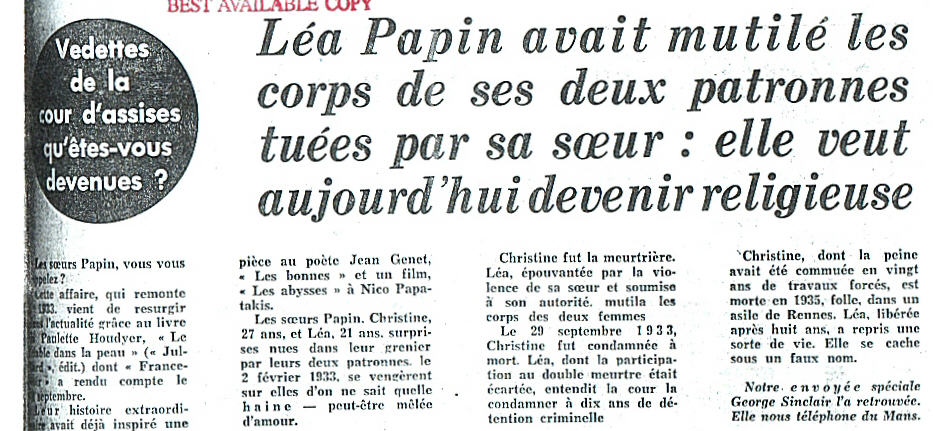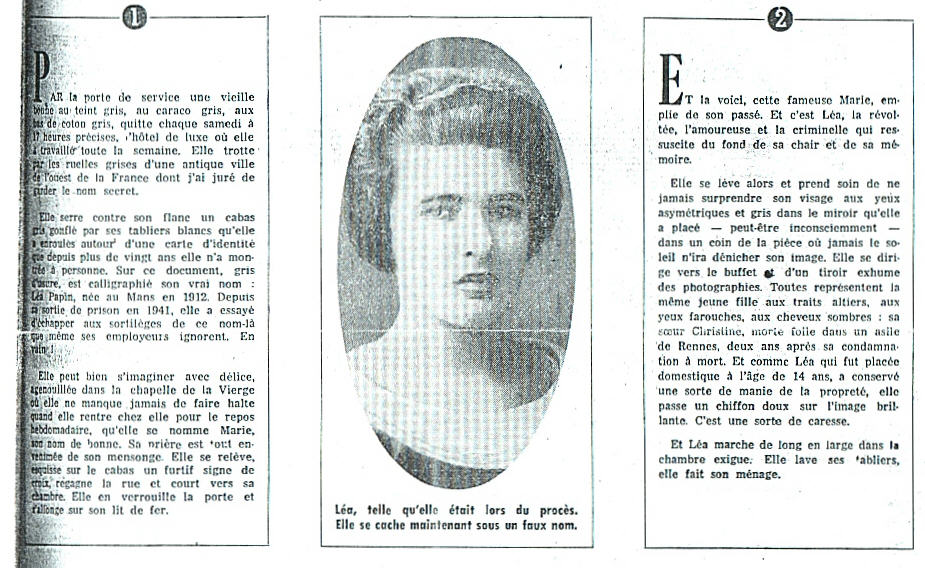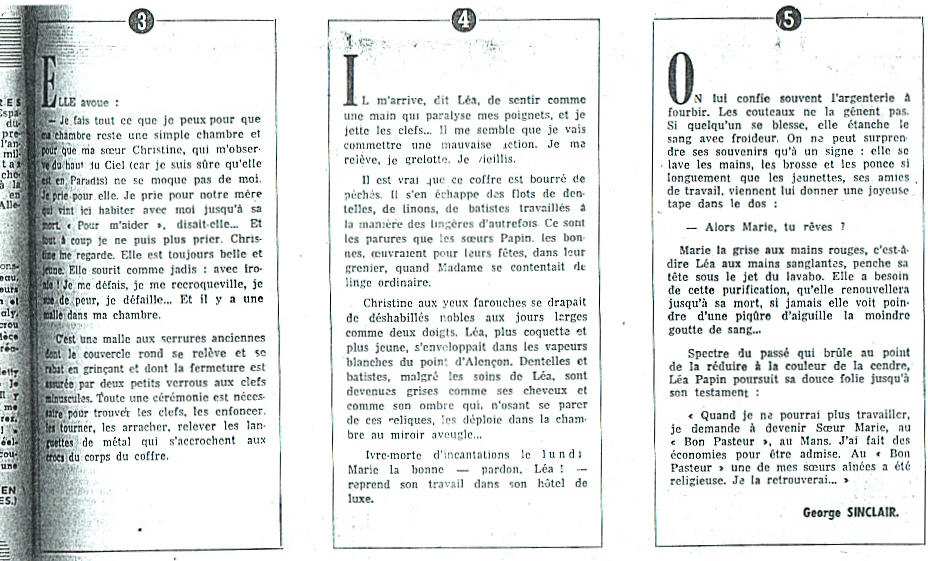Through the service door an
aging maid going grey, wearing a grey blouse and grey dress, leaves
every Saturday at 5pm precisely, the luxury hotel where she has worked
all week. She walks through the grey streets of an old town in the west
of France, but I have sworn to keep the name secret.
She carries at her side a grey shopping bag bulging
with the white aprons rolled around an identity card that she has not
shown to anyone for more than twenty years. On that document, grey from
wear, is printed her true name: Lea Papin, born Le Mans, 1912. Since
leaving prison in 1941, she has tried to escape the curse of that name,
which her employers do not know about. In vain!
She can reflect with delight, kneeling in the chapel
of the Virgin, where she never fails to stop when she is going home for
the weekly break, that the Virgin is named Mary, Lea's adopted alias.
Her prayer is poisoned by her deception. She gains relief, making on the
shopping bag a furtive sign of the cross, and going back across the
street towards her room. She locks the door and stretches out on her
iron bed.
And there she is, that famous Marie, full of her past.
And this is Lea, the rebel, the lover and the criminal who rises from
the core of her flesh and her memory.
She gets up then and takes care to never surprise
herself by turning her grey and asymmetrical eyes to the mirror that is
placed -- perhaps unconsciously -- in a corner of the room where the sun
can never flush her out. She heads towards a wardrobe and takes some
photographs from a drawer. They all depict the same young woman with
haughty features, fierce of eyes and dark of hair: her sister Christine,
who died while mad in the asylum at Rennes, two years after being
condemned to death. And as Lea, who has worked as a domestic since the
age of fourteen, has retained a kind of mania for neatness, she passes a
soft cloth over the shiny image. A kind of caress.
And Lea walks back and forth in the cramped room. She
washes the aprons, she makes her dinner.
She confesses:
"I do what I can to keep my room simple so that
my sister, who watches me from above (because I'm certain she is in
Paradise), doesn't laugh at me. I pray for her. I pray for our mother
who lived with me until she died. To help me, she said...and all
at once I didn't pray anymore. Christine watches me. She is always
beautiful and young. She smiles as in the old days: with irony! I come
apart, I shrivel up, I sweat from fear, I faint...And there's a trunk in
my room."
|
It is a trunk with an old
lock, with a round lid that comes up creakily and which is fastened by
two little bolts that lock. Quite a ceremony is needed to find the keys,
to force them, turn them, tear them back, open the strips of metal which
hang on hooks on the side of the chest.
"I've got it," says Lea, feeling like a hand
that paralyses my wrists, and I throw the keys...It seems to me that I
have committed an evil action. I am shaking. I am getting old.
It is a fact that the chest is brimful of sin. It
overflows with lacy collars, linen, of woven fabrics styled in the
manner of other times. They are the costumes that the Papin sisters, the
maids, made for special occasions, in their garret, while Madame was
content with ordinary linen.
Christine of the fierce eyes made hems as wide as two
fingers. Lea, younger and more stylish, wrapped herself in the white
vapours of Alencon lace. Lacy collars and fabrics, despite Lea's
neatness, are going as grey as her hair and like her shadow which,
having dressed up these relics, displays them in the room to the blinded
mirror...
Intoxicated from incantations, on Monday, Marie the
maid -- pardon, Lea! -- resumes her work at the luxury hotel.
They often give her the silverware to prepare. The
knives are not ready. If something gets damaged, her blood freezes. One
is not surprised by the memories of these gestures; she washes her
hands, brushes and pumices them much longer than the younger girls, her
workmates, who give her a friendly slap on the back:
"So Marie, are you dreaming?"
The grey Marie with the red hands, ie Lea with the
bloody hands, tilts her head under the stream of water. She needs that
purification, which she must renew until her death, if she never wants
to feel the sting, like a needle, at the slightest trace of blood...
Haunted by the past, which burns to the point of
reducing her to the colour of ashes, Lea Papin pursues her gentle
madness until her testament:
"When I don't have to work anymore, I want to
become Sister Marie, at Bon Pasteur, in Le Mans. I've been saving for
it. At Bon Pasteur, one of my older sisters is a nun. I'll go back to
her..."
........George Sinclair
(Translated from the French by Neil Paton. Translation Copyright N. Paton 2001)
BELOW: ORIGINAL ARTICLE IN FRENCH.



BACK TO CHRISTINE AND LEA
PAPIN